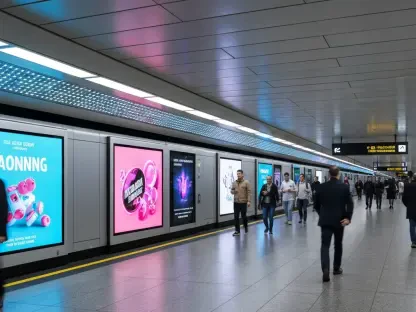The Digital Advertising Landscape: A Shifting Paradigm
In the bustling realm of digital advertising, a staggering $60 billion market in the UK underscores the industry’s pivotal role in shaping consumer behavior and brand success, reflecting not only economic stakes but also the transformative power of technology. This dynamic sector, fueled by constant innovation, serves as a battleground for both established giants and emerging platforms vying for consumer attention. The sheer scale of investment highlights the ever-evolving ways in which brands connect with audiences through cutting-edge tools and strategies.
Key players like Google dominate with text-based search models, commanding significant market share through precise keyword targeting. Meanwhile, visual platforms such as Pinterest carve out a unique niche by prioritizing image-driven discovery, appealing to users seeking inspiration over structured queries. This dichotomy highlights a broader shift in how digital spaces cater to diverse user needs, with each platform refining its approach to maximize engagement and advertiser value.
The influence of artificial intelligence and automation has further reshaped this landscape, streamlining campaign management and enhancing targeting precision. Coupled with the rising prominence of visual discovery, these technologies challenge traditional advertising norms, pushing brands to adapt to a more intuitive, image-centric consumer journey. However, sustaining engagement across platforms remains complex, as text-based search struggles with articulation barriers, revealing cracks in conventional models that newer, visually oriented solutions aim to address.
Pinterest’s Visual Search Revolution: Trends and Insights
Emerging Consumer Behaviors and Technological Advancements
A notable trend in consumer behavior reveals that 52% of UK consumers face difficulties in articulating their needs through keywords on traditional search engines. This significant barrier often leads to frustration and missed opportunities for brands relying solely on text-based systems. Visual search emerges as a compelling alternative, offering an instinctive way for users to explore products and ideas through images rather than words.
Pinterest has capitalized on this shift, reporting a 44% year-over-year increase in visual search queries, reflecting a growing preference for this mode of discovery. The platform’s AI-driven tools, such as the Performance+ suite and multimodal search capabilities, enhance user experience by delivering more relevant results and boosting campaign efficiency for advertisers. These advancements enable brands to connect with audiences at critical moments of inspiration, transforming casual browsing into actionable intent.
Particularly among Gen Z, Pinterest stands out as a preferred starting point for shopping searches, with 39% of this demographic favoring the platform over conventional engines. This trend underscores an opportunity for advertisers to engage users early in their shopping journeys, leveraging visual content to inspire and guide decisions. By aligning with these behavioral shifts, brands can tap into a more engaged and receptive audience, redefining how connections are forged in the digital space.
Market Performance and Growth Projections
Pinterest’s growth metrics paint a picture of robust expansion, with 570 million monthly active users globally and a Q2 revenue of $998 million, marking a 17% increase from the previous year. These figures highlight the platform’s rising influence in the digital advertising arena, as it continues to attract a diverse user base hungry for visual inspiration. The shift toward commerce is evident, with shopping ads now constituting 30% of international revenue, up significantly over recent years.
Looking ahead, industry forecasts align with Pinterest’s trajectory, as WPP Media predicts that AI-generated creative content will dominate advertising by 2030. This projection suggests a future where visual search platforms could claim a larger share of the market, challenging the supremacy of text-based models. Pinterest’s focus on integrating AI and visual discovery positions it favorably to lead this transformation, offering advertisers innovative ways to stand out.
The platform’s evolution signals a broader redefinition of market dynamics within digital advertising. As visual search gains traction, it is poised to reshape how brands allocate budgets and strategize campaigns, potentially shifting focus from keyword precision to image-driven storytelling. This forward-looking perspective emphasizes the need for advertisers to adapt swiftly to maintain relevance in an increasingly visual marketplace.
Challenges in Traditional Search Advertising
Traditional search advertising, long a cornerstone of digital marketing, grapples with inherent limitations that hinder its effectiveness. A primary issue is the articulation barrier, where many consumers struggle to formulate exact keywords, leading to irrelevant results and diminished user satisfaction. This friction underscores a fundamental flaw in text-reliant systems that fail to capture nuanced user intent.
Technological disruptions compound these challenges, as AI-generated search overviews on platforms like Google sometimes dilute the precision of results, altering how information is accessed. The gradual erosion of exact match keyword functionality further complicates targeting efforts, leaving advertisers with less control over campaign outcomes. Such shifts reveal the vulnerabilities of sticking to outdated models in a rapidly changing digital environment.
To address these obstacles, integrating visual search tools offers a promising path forward, reducing friction in the user journey by prioritizing intuitive discovery over rigid text inputs. Brands must also adapt to evolving consumer preferences for image-based exploration, rethinking strategies to align with these new patterns. Embracing hybrid approaches that combine visual and textual elements could bridge existing gaps, ensuring broader reach and relevance in a competitive market.
Regulatory and Compliance Considerations in Visual Advertising
The regulatory landscape for digital advertising imposes stringent guidelines that platforms and brands must navigate to maintain trust and legality. In the UK and globally, data privacy laws demand transparency in how user information is collected and utilized, while brand safety standards protect against inappropriate content associations. These regulations shape the operational framework within which visual advertising must function, balancing innovation with accountability.
Pinterest addresses these requirements through features like negative keyword filters and customizable brand safety parameters, ensuring campaigns align with advertiser values and legal mandates. Such measures foster a secure environment for both users and brands, reinforcing the platform’s commitment to ethical practices. Compliance becomes not just a legal necessity but also a competitive advantage, enhancing credibility in a crowded market.
The rise of AI-driven advertising tools introduces additional regulatory scrutiny, necessitating clear disclosure of automated processes in campaign management. Transparency in how algorithms influence ad placements and targeting is critical to maintaining user trust and meeting global standards. As visual search platforms expand, adherence to these principles will continue to play a pivotal role in shaping advertiser confidence and sustaining long-term growth.
The Future of Advertising: Visual Search as a Game-Changer
Visual search stands poised to revolutionize advertising, with Pinterest at the forefront of this transformation through its pioneering use of AI and automation. The platform’s ability to seamlessly blend inspiration with actionable commerce sets a new benchmark, encouraging brands to rethink how they engage with audiences. As technology advances, the potential for even deeper personalization and efficiency in campaigns promises to elevate the user experience further.
Strategic partnerships with e-commerce ecosystems, such as those with Kroger Precision Marketing and Instacart Ads, signal a future where visual search integrates more closely with retail environments. These collaborations expand Pinterest’s reach, enabling advertisers to connect with consumers at multiple touchpoints along the purchasing journey. Such integrations could redefine how brands drive conversions, merging discovery with direct action in unprecedented ways.
Shifting consumer preferences toward visual and lifestyle-driven content over traditional text queries will likely accelerate this trend, supported by global economic conditions and technological progress. Within the $60 billion UK advertising market, these factors suggest a growing appetite for platforms that prioritize intuitive, image-based exploration. As these elements converge, visual search is set to become not just an option but a central pillar of effective advertising strategies in the years ahead.
Conclusion: Pinterest’s Vision for a Visual Advertising Era
Reflecting on the insights gathered, Pinterest has carved a distinctive path by tackling consumer articulation challenges head-on with its innovative visual search and AI-driven tools. The platform’s impact is evident in metrics like a 3.8x higher return on ad spend for large catalogs, alongside compelling case studies from brands like Wickes and Wayfair that showcase tangible success. These achievements highlight how visual discovery transcends traditional barriers, offering a fresh lens through which brands connect with audiences.
Looking back, the journey underscores a pivotal shift from mere inspiration to actionable commerce within digital advertising. For advertisers, the next steps involve embracing visual-first strategies, leveraging AI automation to streamline efforts, and prioritizing early-stage engagement to capture consumer intent. Exploring partnerships and integrating with broader e-commerce ecosystems offer additional avenues to amplify reach and impact.
Ultimately, the focus turns to continuous adaptation, as staying ahead demands a willingness to experiment with emerging tools and align with evolving user behaviors. Pinterest’s blueprint provides a starting point, but sustained growth hinges on a proactive stance—investing in technology and creativity to transform visual search into a cornerstone of advertising success in an ever-changing landscape.









